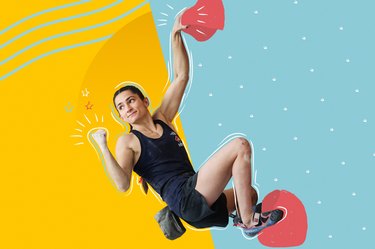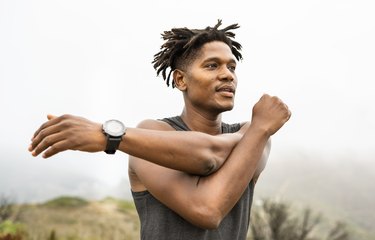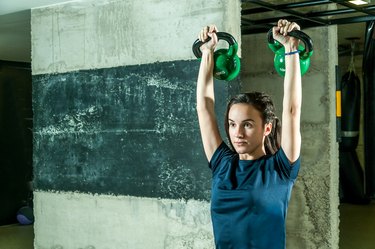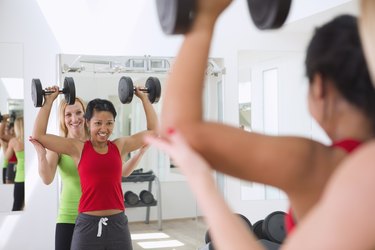

Athletes in the Olympic and Paralympic Games share their top tips so you can fuel your body and rock your workouts Like an Olympian.
Imagine dangling from a climbing wall by one arm. Your legs are at least 10 feet from the ground and there's no rope or harness to catch you if you fall.
Sound daunting? Well, it's routine for professional climber Kyra Condie (just check Instagram for proof).
Video of the Day
Condie is one of four American athletes competing in sport climbing at the 2020 Tokyo Olympics. It's a new sport for the Summer Games and includes three different events: lead climbing (climbing 49-foot walls with a rope), speed climbing (climbing a 49-foot wall as quickly as possible) and bouldering (climbing a 15-foot wall without a rope).
Although Condie makes the sport look easy, her path to success has, at times, been trying. At age 12, shortly after she started competitive climbing, she discovered she had scoliosis and had to undergo corrective spinal surgery. This meant a total pause from the sport.
"[The surgery] was the biggest physical obstacle I encountered in my career," she tells LIVESTRONG.com. "Now, I think I'm actually pretty good at knowing what I can and can't control."
That lesson has been critical to her success as a climber: She won her first major competition in 2012, just months after surgery, according to the International Federation of Sport Climbing.
Since then, she has competed and placed in dozens of international competitions. In 2019, she went on to become the first American woman semi-finalist at the climbing World Championships in Japan. That year, she also she secured her spot in the Tokyo Olympics, winning seventh place overall in the qualifying event, according to her website.
Like a lot of challenges in life, the hardest thing about climbing is that you rarely know what kind of problem you're going to get, Condie says. In bouldering, routes are actually called "problems" for that reason: The climber's goal is to adapt and solve them. You can prepare for all sorts of situations and still be surprised on competition day.
"If I encounter a move that I can't do because I wasn't able to pull hard enough, I know I can go back and start training," she says.
So what does it take to be one of the best climbers in the country? While Condie spends countless hours training on the wall and in the gym, she credits a lot of her success (and amazing upper-body strength) to one simple at-home exercise.
We spoke with Condie before the Games to learn about the move and exactly how you can use it to build gravity-defying shoulders, too.
The One Exercise Kyra Condie Swears By
Condie does lots of types of training, but the one move she can't live without isn't some intense Olympic lift. It's actually a warm-up and injury-prevention move: the shoulder rotation.
"Since incorporating the exercise into my warm-up in the last four or five years, I've never had a shoulder injury, knock on wood," she says. "It's a proper warm-up and strengthens all the small shoulder muscles."
For ultimate benefits, she does the exercise in two directions (internal and external rotation) before every climbing session.
Train Like an Olympian Before Your Next Workout
Ready to start building Kyra Condie-level shoulder strength and stability? Here, Melissa Garcia, DPT, a Washington-based physical therapist, demonstrates how to do shoulder rotations with good form.
Do 1 set of internal rotations with both arms, then repeat with external rotations. Go back and forth between the two directions until you finish 3 sets of each.
Internal Shoulder Rotation
- Attach a resistance band to a sturdy object at torso height. Stand so that it's on your left.
- Grasp the free end of the band with your left hand and take several steps away from the anchor point until the band is taught.
- Stand tall with your left elbow bent to 90 degrees and pressed against your side.
- Starting with your forearm out to your side, pull the band toward the center of your body while keeping your elbow tight to your side.
- Pause, then slowly return to the band to your side.
Tip
If you're having trouble keeping your elbow still, place a rolled up towel between your arm and your ribs and hold it in place while you do the move. If you can't help but let your elbow stray, try using a lighter resistance band, Garcia says.
External Shoulder Rotation
- Attach a resistance band to a sturdy object at torso height. Stand so that it's on your right.
- Grasp the free end of the band with your left hand and take several steps away from the anchor point until the band is taught. The band should cross in front of your body.
- Stand tall with your left elbow bent to 90 degrees and pressed against your side.
- Starting with your forearm diagonally across your body, pull the band away from the anchor to your side while keeping your elbow tight to your side.
- Pause, then slowly return to the band in front of you.
The Best Resistance Bands for Shoulder Rotations
To learn more about all the Team USA athletes, visit TeamUSA.org. Watch the Tokyo Olympics beginning July 23 and the Tokyo Paralympics beginning August 24 on NBC.




